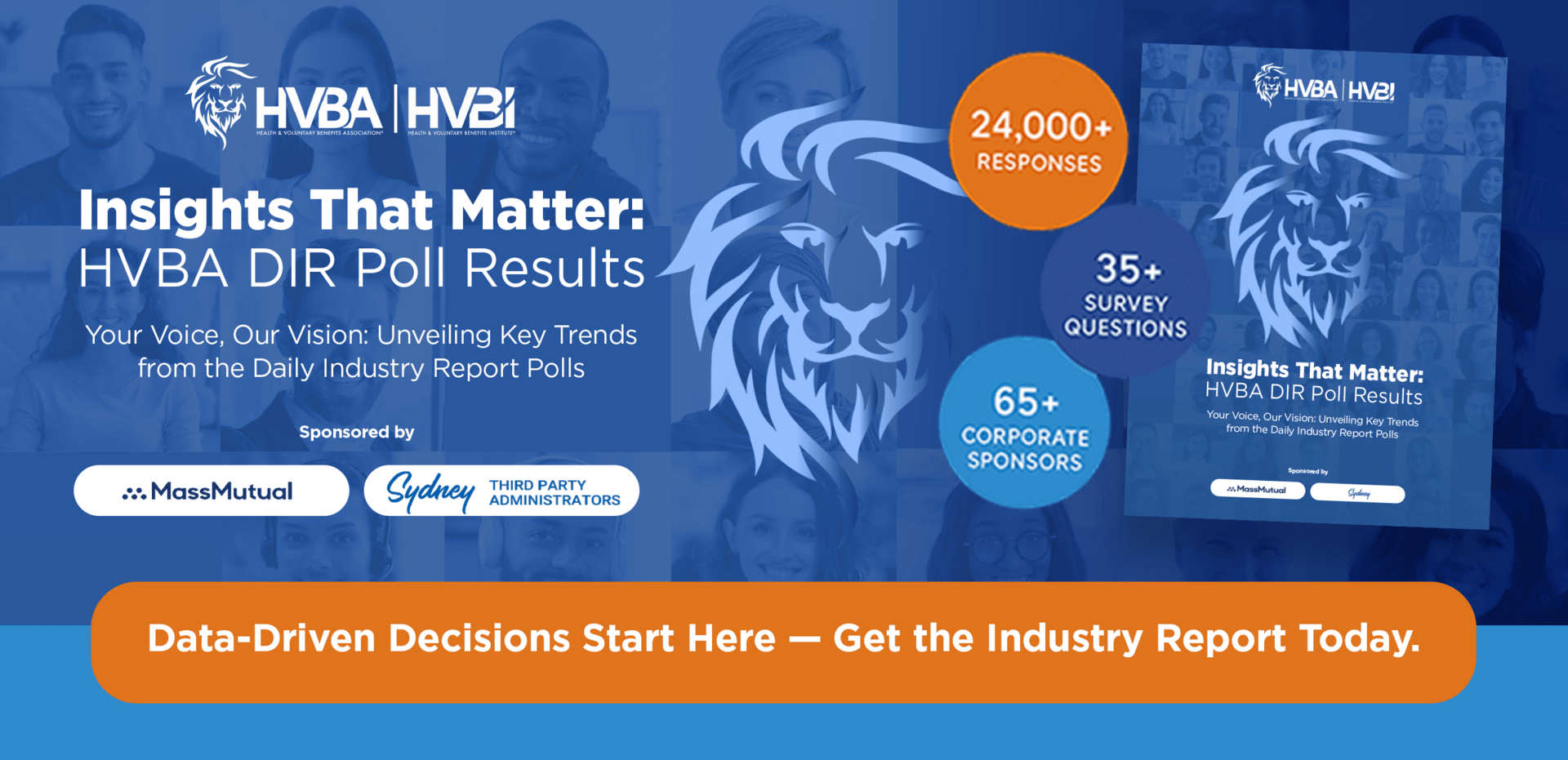- Daily Industry Report
- Posts
- Daily Industry Report - August 1
Daily Industry Report - August 1

Your summary of the Voluntary and Healthcare Industry’s most relevant and breaking news; brought to you by the Health & Voluntary Benefits Association®
Jake Velie, CPT | Robert S. Shestack, CCSS, CVBS, CFF |
Trump escalates demands that pharma companies lower their drug prices
By Elaine Chen - President Trump escalated his demands that pharma companies lower U.S. drug prices in line with what other countries pay, sending letters to 17 major drug companies Thursday that called on them to take actions by Sept. 29. Read Full Article… (Subscription required)
HVBA Article Summary
Trump Administration's Drug Pricing Push: The Trump administration has formally requested that leading pharmaceutical companies lower the prices of their entire drug portfolios for Medicaid to match those found in other wealthy nations, offer new drugs at those lower prices across Medicare, Medicaid, and commercial plans, and implement direct-to-consumer sales for certain high-rebate drugs. Additionally, it urged companies to repatriate overseas earnings. However, the letters did not specify any legal authority or clear enforcement mechanisms, instead issuing broad threats of government action if companies do not comply.
Industry Response and Concerns: Major pharmaceutical firms and industry trade groups such as PhRMA and BIO have opposed the administration’s demands, arguing that price controls could weaken American innovation and competitiveness in the biopharmaceutical sector. They assert that cost issues stem largely from middlemen in the supply chain, such as pharmacy benefit managers, and advocate for systemic reforms to reduce inefficiencies rather than direct price mandates.
Mixed Industry Movement and Feasibility Questions: Although a few companies, including Eli Lilly and Pfizer, have already taken steps toward lower-priced, direct-to-consumer models for select medications, analysts suggest that Trump’s broader pricing demands are likely unfeasible. They warn of significant negative consequences for U.S. drugmakers, including reduced revenues and weakened competitiveness, particularly against global rivals such as China’s growing biopharma industry.
HVBA Poll Question - Please share your insightsShould A&H carriers provide a 1099 for Accident, Critical Illness, and Hospital Indemnity claims exceeding $600? |
Our last poll results are in!
59.38%
Of Daily Industry Report readers who participated in our last polling question, when asked, “What strategies do you feel are most effective to gain deeper transparency into — and thereby better manage — total pharmacy spend?” responded with “disaggregate PBM management & functions (formularies, clinical, claims, network access & rebates).”
25% feel the most effective strategies are to “leverage robust data & reporting tools that allow you to analyze costs and trends,” while 9.37% believe it to be “partnering with a smaller, more flexible PBM that will allow formulary customization.” The remaining 6.25% feel that “carve-out specialty vs. traditional drugs, especially the biosimilar drugs,” are the most effective strategies to gain deeper transparency into — and therefore better manage — total pharmacy spend.
Have a poll question you’d like to suggest? Let us know!
By Allison Bell - The prices that self-insured employers are paying for medical stop-loss this year may be increasing a little more slowly this year than in 2024. Analysts at the Segal Group, a New York-based benefits and compensation consulting firm, found that stop-loss prices for employers that held benefits the same are 9.7% higher this year than they were last year. Read Full Article… (Subscription required)
HVBA Article Summary
Moderating Premium Increases: Employers that kept their health benefits unchanged experienced a slowdown in the rate of stop-loss premium increases, dropping from 11.5% in 2024. Those that implemented cost-control measures, such as raising deductibles, saw an even more significant moderation, with rates rising by 7.3%, down from 9.4% the previous year. This suggests that proactive plan adjustments can help manage premium growth.
Shifting Deductible Trends: There is a clear movement toward higher stop-loss deductibles among employers with self-insured plans. The percentage of plans with deductibles under $400,000 fell from 51% to 47%, while those with deductibles of $700,000 or more increased from 16% to 19%. This shift indicates a growing willingness among employers to assume more financial risk in exchange for lower premium costs.
Mixed Future Outlook: Looking ahead, rising stop-loss insurance premiums could lead some employers to explore alternatives, such as switching to fully insured plans or going without stop-loss coverage. However, projections of increasing costs for fully insured group health plans may instead encourage more employers to self-insure, potentially stabilizing the stop-loss insurance market by 2026.
Cost for Health Care in Retirement Hits $172,500, per Fidelity Report
By Yasin Mohamud - A 65-year-old retiring in 2025 can expect to spend an average of $172,500 for health care and medical expenses throughout retirement, according to Fidelity Investments annual Retiree Health Care Cost Estimate report. The report, which is the firm’s 24th, noted that this new average represents a more than 4.5% increase over last year’s estimate of $165,000 and that it “continues the general upward trajectory of projected health-related expenses” since Fidelity’s first estimate of $80,000 in 2002. Read Full Article…
HVBA Article Summary
Many Americans are underprepared for retirement health care costs: A large number of Americans, particularly those in Generation X, have not adequately considered or planned for the medical expenses they may face in retirement. According to Fidelity's research, 1 in 5 Americans have never thought about these needs, and 17% have taken no action at all to prepare—highlighting a widespread lack of engagement with this critical aspect of retirement planning.
Fidelity’s 2025 estimate highlights the gap in Medicare coverage: The cost estimate assumes retirees are enrolled in Medicare Parts A, B, and D, which cover many—but not all—health-related expenses. Notably, it excludes long-term care, dental, vision, and over-the-counter medications. This underscores the importance of recognizing that Medicare alone may not fully protect retirees from rising out-of-pocket costs.
Health Savings Accounts (HSAs) are underutilized despite their benefits: HSAs offer a triple-tax advantage and are a powerful tool for managing retirement health care costs, yet they remain underused. Only 15% of Americans aged 55–64 have an HSA, and over half of those are unaware that HSAs can serve as a long-term savings vehicle. New legislation expanding eligibility in 2026 may help close this knowledge and access gap, potentially increasing HSA adoption.
Workers want personalized benefits, but companies are struggling to keep up
By Caroline Colvin - Offering benefits that address workers’ unique needs continues to be a topic of conversation. A July report from Gallagher indicated that employers were increasingly interested in providing voluntary benefits. This included quality-of-life perks such as pet insurance, accident assistance and adult day care and other caregiver support. Read Full Article…
HVBA Article Summary
Rising Costs vs. Employee Expectations: Employers are increasingly caught between two opposing pressures—managing the rising cost of healthcare, largely due to medical inflation, and meeting employee expectations for more flexible, personalized, and valuable benefits. This tension is creating a complex environment for benefits planning and delivery.
Shifting Strategies: To navigate this landscape, a majority of employers are planning proactive steps such as renegotiating contracts with current benefits providers (77%) or seeking new proposals through vendor RFPs (67%). At the same time, many are shifting more financial responsibility to employees, with about half of large employers considering higher deductibles or out-of-pocket maximums in the near future.
Importance of Data and Personalization: As benefit programs evolve, leaders emphasize the critical need for accurate data to drive informed decisions and ensure offerings support employee well-being across physical, emotional, and financial dimensions. There is also a growing movement toward delivering a consumer-grade experience that aligns benefits with individual employee needs, even as organizations grapple with cost and operational complexity.
A quarter of hospitalized Medicare patients experience preventable harm, report finds
By Alan Goforth - Patient harm events can result in in Medicare recipients not receiving the quality, affordable hospital care they expect and for which they pay. One-quarter of hospitalized Medicare patients experienced harm events during their stays in October 2018, and 43% of these could have been prevented if patients had received better care, according to a new report from the Department of Health and Human Services’ Office of Inspector General (OIG). Read Full Article… (Subscription required)
HVBA Article Summary
Widespread Patient Harm Remains Underreported: Although there has been national attention on improving patient safety, the report found that hospitals failed to capture 49% of patient harm events among hospitalized Medicare patients. This underreporting was largely due to hospitals using narrow definitions of harm or lacking consistent standards for what should be reported.
Limited Investigation and Follow-Up: Among the harm events that hospitals did record, only a small number were formally investigated, and even fewer resulted in safety improvements. This lack of follow-through prevents hospitals from learning from adverse events and contributes to the continued presence of preventable harm in healthcare settings.
Call for National Standardization: The report recommends that the Agency for Healthcare Research and Quality (AHRQ) and the Centers for Medicare & Medicaid Services (CMS) lead a coordinated effort to develop a standardized classification system for patient harm. This would help align definitions across healthcare providers, improve reporting accuracy, and enhance the ability to share best practices and improve safety nationwide.
UnitedHealthcare dropping some Medicare Advantage plans, affecting 600,000
By Christopher Snowbeck - UnitedHealth Group’s massive health insurance business will drop Medicare Advantage health plans covering more than 600,000 people as it tries to reverse its financial decline. The company’s insurance arm, UnitedHealthcare, is the nation’s largest provider of Medicare Advantage health plans, a privatized version of the original government health insurance program. Read Full Article…
HVBA Article Summary
Financial Strain from Higher-than-Expected Medical Costs: UnitedHealth Group is facing significant financial challenges due to rising medical costs that have outpaced premium revenues. This includes a higher volume and intensity of care in both Medicare Advantage and ACA (Affordable Care Act) individual markets, leading to reduced profit margins and missed earnings forecasts.
Strategic Retrenchment in Health Plan Offerings: In response to these pressures, UnitedHealth plans to scale back Medicare Advantage benefits and may exit certain ACA exchange markets in 2025 if rate adjustments cannot offset rising costs. The company also cut back its planned expansion in value-based care arrangements within its Optum Health division.
Leadership and Cultural Shift Amid Industry Scrutiny: Following executive changes and public criticism over claims practices, UnitedHealth’s returning CEO Stephen Hemsley emphasized a renewed focus on values and reform. The company is navigating increased regulatory scrutiny, particularly regarding Medicare billing practices, while facing broader industry pressures around transparency and cost control.

How Financial Stress Takes a Toll on Your Health
By Kayla Webster - Not being able to pay your bills isn’t just bad for your credit score — it can actually make you sick. Financial stress has been linked to causing migraines, high blood pressure, stomach ulcers, and even heart attacks, according to a two-year study by Financial Finesse — the very first financial coaching employee benefit company. Read Full Article…
HVBA Article Summary
Widespread Financial Stress Among U.S. Workers: A study by EarnUp found that 78% of U.S. workers live paycheck to paycheck, making them vulnerable to mental health struggles such as depression and anxiety. Chronic financial stress is linked to serious health outcomes including cardiac events and strokes, according to the Mayo Clinic.
Employer Costs and Productivity Impacted by Financial Wellness: Data from Financial Finesse revealed that employees who used financial coaching reduced employer health care costs by nearly 5%, while those who did not use the service increased costs by almost 20%. Financial stress not only harms employee health but also negatively affects workplace productivity and increases absenteeism.
Behavioral Improvements Linked to Financial Stability: Clients who received financial coaching reported adopting healthier habits, such as regular exercise and improved nutrition. One individual reduced his body fat percentage significantly within six months of engaging with a coach. In another study, truck drivers who followed a savings plan had fewer accidents and driving citations, showing that financial well-being can enhance both personal health and job safety.







